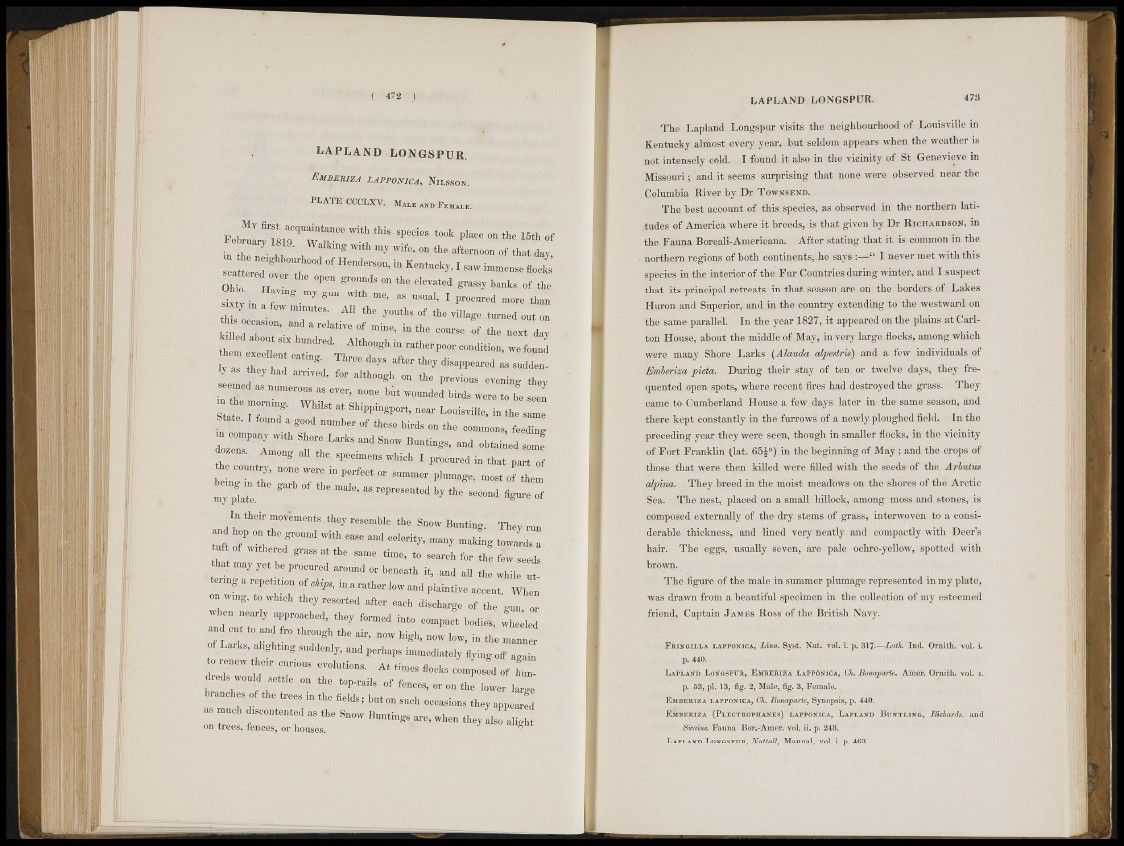
L A P L A N D Li ON ©SPUR.
MMBERIZA LJPPONICA, NILSSON.
T L A T E •eociixv. M . ^ iK1) P ema l e , BsBBi B U I H111 IMH 5H S, 3Sg BI 3 I •I H• i ¡I gthat,idaly,I i ^ a t t e r e I over the open grounds on ^ elated grassy banks of.thl HHHhI I • • 1 n • • • H I ^ 1 • • .turned out on
in the course of the „ ^ day
K Mod rt„,l six Although in ratherjmor condition-, we found
i i i l M M i ^ H H H , we.iopnd
Was B B H H H U H as,sudden.
7 8 f e y t a d % although on the previous evgning they
in tfi aS wounded birds wer^to be t Z rrzr nBHBI^^B State, I fopni a g o o d lulrnI ,
e r o f ,ho,e birds on the commons, f e e d i l l „ • Bithe •^•BHIHBi
the country, none were in perfect or summer plumage, most of the»
b ^ n the g,b.of % male,1?s represented.by J s e eond- . fi^Tf
d
e m I n t B—h e . r t n o l ^ , , ^• •We S ^ IS gnow •. - • m
tuft o r d e r e d grass at the ^ e tune, to search for the £ ses
hat ma? yet be procured around or r.enoath it, and a., the vvhil „
tering a j e j > ^ t i o n of d^ps, m a rather low and plaintive accent. When
• • • * * * «ft* • discharge „f i H |
«• on n,.r ) y approached, M Wed into compact bodiel, i e d
« d cut jganfl fro ^ u g h the air, now high, no„ l o w , in the ma^er
B^f Larks,^lgBljitiSg suddeSnly, and peSrhaps imme1diately flyin2g off agato dreds would «ettle on th, of 0r on the lo*er l a l
branches of the .in the fields,- butonsuch o n i o n s t h e y a p p Z
as muck discontented as the Snow Bunt ings,^, when they L f a ^
on trees, fences, or houses. , ".....„ , K
LAPLAND LONGSPUR. 4 7 3
The Lapland Longspur visits the nceighbourhood of Louisville in
Kentucky almost every year, but seldom appears when the weather is
not intensely eold. I found it also in the vicinity of St Genevieve in
Missouri ; and it seems surprising that none were observed near the
Columbia Hi ver by Dr TOWNSKSD.
The best: afiPQunt of this speeiesi as observed in the northern latitudes
of America whei'e it breeds, is that given by Dr R ICHARDSOK, in
the Fauna Boreali-Americana. After slating that it is common in the
northern regions of both continents, he says :—" I never met with this
species in the interior of the Fur Countries during winter, and I suspect
that its principal retreats in that season are on the borders of Lakes
Huron and Superior, and in the country extending to the westward on
the same parallel. In the year 1827, it appeared on the plains .at Cart
ton House, about the middle of May, in very large Hocks, among which
were many Shore Larks (Alauda alpestri*) and a few individuals of
Émberiza pietà. During their stay of ten or twelve days, they frequented
opon spots, wherci recent fires had destroyed the grass. They
came to.Cumberland House a few days later in the same season, aind
there kept constantly in the furrows of a newly ploughed field. In the
preceding year they were scon, (hough in smaller flocks,' in the vicinity
of Fort Franklin (lat. 66J®) in the beginning of May | and the crops of
those that were then killed were filled with thè seeds» of the Arbutus
alpina. They breed in the moist meadows on the shore's of the Arctic
Sea. The nest, placed on a small hillock, among moss and stones, is
composed externally of the dry stems of grass, interwoven to a considerable
thickness, and lined very neatly and compactly with Deer's
hair. The eggs," -usually-' seven, are pale ochre-yellow, spotted with
brown.
The figure of the male in summer plumage represented in my plate,
was drawn from a beautiful specimen in the collection of my esteemed
friend, Captain J A M E S Ross of the British Navy.
FRTNGTT.LA LAPPONICA, Linn. Syst. Nat. vol. i. P . 317.—Lath. Ind. Ornith. vol. i.
. fjftSti v: -I
L A T L A N D LONGSPUR, EMHERIZA LAPPONICA, Ch. Bonaparte. Ajner. Ornith. vol. i.
p. 53, p'.. 13, fig. 2, Male, %. 3, Female.
E M B E R I Z A LAFFONICA, Ch. Bonaparte, Synopsis, p. 440.
E M B E R I Z A (PLECTROPHANES) LAPP ON ICA, LAPLAND BUNTLING, Iiichwrds. and
Stimm. Fauna Bor.-Amei. vóL ii. p. 248.
LAPLAND LONGSPUR, JVTIIIOZI, Manual , vol. i. p . 463.